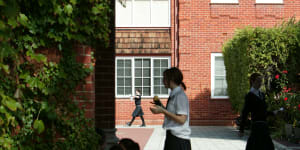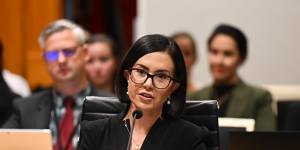State education ministers are calling for the Commonwealth to close the gap in capital infrastructure spending,with a one-off $215 million public school upgrade program set to expire,and new analysis by the Australian teachers’ union revealing twice as much money is being spent on private infrastructure per student as public.

State education ministers are calling for the Commonwealth to close the gap in capital infrastructure spending.Erin Jonasson
In a report to be released on Friday,Australian Education Union researchers analysed school spending on capital works via Australian Curriculum,Assessment and Reporting Authority data,taking in both government funding and money spent by non-government schools from other large revenue sources such as parent fees,investments and donations.
Five private schools – Cranbrook School,Barker College and Abbotsleigh College in NSW,and Caulfield Grammar and Loreto Mandeville Hall in Victoria – spent a combined $175.6 million on capital works in 2021. That’s more than all governments spent that year on capital works at half of the nation’s 6699 public schools.
That same year,Cranbrook spent more on works ($63.48 million) than the total public school capital expenditure of Tasmania and the Northern Territory combined ($62.4 million). Just two schools in Victoria,Haileybury College and Caulfield Grammar,together spent more in the decade from 2012 to 2022 than the entire Tasmanian public school system did. There are 190 public schools in Tasmania.

NSW Education Minister Prue Car.Janie Barrett
The new data comes ahead of a key meeting with federal Education Minister Jason Clare on Friday,when six states and territories including NSW,Victoria and Queensland,will push for the Commonwealth to lift its share of overall public student funding by 5 per cent.
Public schools across the country are still every year,while of the Gonski resourcing standards designed to fund schools according to need.
The states provide the bulk of public school funding,but they say the Commonwealth should re-establish a permanent dedicated fund for public school capital works,as non-government schools have already.
NSW Education Minister Prue Car told this masthead that,as the state tried to close the student funding gap for public schools,“in parallel,the Commonwealth should consider long-term funding for school infrastructure,as recommended in the original Gonski review”.

Victorian Education Minister Ben Carroll said:“While we’ve made unprecedented investments in school capital in the past nine years,we shouldn’t have to go it alone.”
South Australian Education Minister Blair Boyer said it was outrageous that the Coalition abolished the public school infrastructure fund in 2017,and it should be restored in the next funding agreements,which are being negotiated between the Commonwealth and states this year.
Non-government schools are not meant to spend government funding for students on infrastructure. That is sourced from elsewhere,primarily parent contributions,though schools do not publicly itemise where government funding is spent in the data.
Private and Catholic schools also have access to a long-standing Commonwealth capital fund,which,according to budget papers,will deliver almost $1 billion over the next four years.
That’s primarily schools build infrastructure for disadvantaged students. But since 2019,more than $40 million has instead been funnelled to wealthy privates.
While spending on richer colleges has fallen in recent years,10 advantaged schools still received funding through the scheme this year. St Andrew’s Christian College in Victoria,for example,ranks among the nation’s top 3 per cent of advantaged schools,and received $1 million to buy land.
Education economist Adam Rorris helped devise the Commonwealth’s minimum student funding standards,known as the SRS,and has previously analysed capital spending independently. Some years,private school capital spending was up to four times greater than public funding,he said,adding government funding for the big private schools was “fungible” because it’s a “top up to their own funds … which then means spillover money is diverted for school halls and swimming pools”.
Research shows school infrastructure is important for student outcomes,he said,as public school principals across the country speak of struggles to fund basics such as working toilets and airconditioning. “They’ve been systematically starved of funds,” he said.
Margery Evans of the Association of Independent Schools of NSW said that school communities fund more than 90 per cent of capital works,“usually by repaying loans over 20 years”.
“Applications for the limited pool of government capital grants each year are assessed and allocated to independent schools based on need,and only ever fund a portion of the project cost,” she said,usually for extra classrooms in fast-growing suburbs or “upgrades for schools serving low socio-economic communities”.
States are still falling,but have invested more in capital infrastructure in recent years,especially in NSW and Victoria.
Western Australia has already struck a deal that will see the Commonwealth raise its long-standing share of public school funding by 2.5 per cent, to demand the 5 per cent rise.
When the union unveils the new report on Friday,Greens leader Adam Bandt is expected to call for a $500 million fund for public school capital works.
Bandt says the Greens will now try to block any legislation that fails to deliver at least a 5 per cent increase in Commonwealth funding for public schools.

Get the day’s breaking news,entertainment ideas and a long read to enjoy.